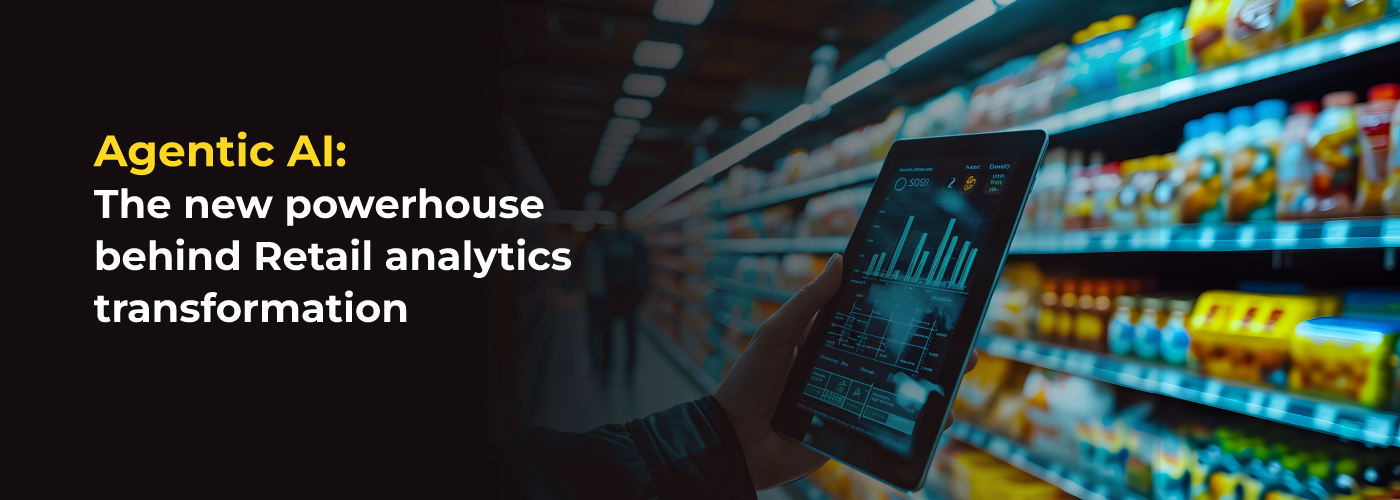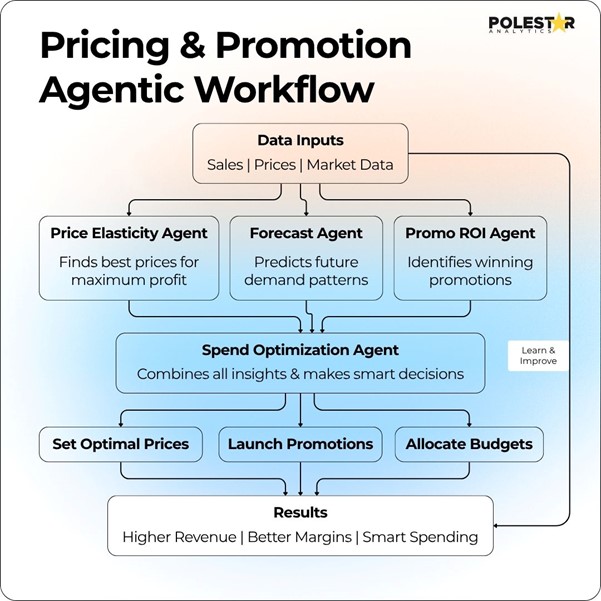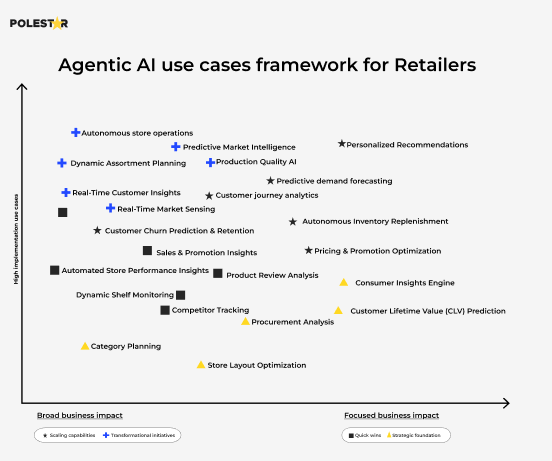
Sign up to receive latest insights & updates in technology, AI & data analytics, data science, & innovations from Polestar Analytics.
In our previous exploration around Agentic AI in Retail, we've explored how autonomous intelligence is rewiring core retail functions—from customer engagement to operational efficiency. But beneath all those advancements lies a deeper story—one that sits at the very heart of retail transformation: Data.
No matter how advanced these systems become, their intelligence is only as good as the data they operate on. This brings us to one of the most overlooked, yet foundational, challenges in retail analytics — data harmonization.
As Jason Villano emphasized in our recent RGM session:
“Both CPG companies and retail customers face challenges with data harmonization due to varying naming conventions and product identifiers (like 12-digit versus 10-digit UPCs) when products are set up differently in various retail systems.”
This fragmentation creates friction in every downstream process—from demand forecasting to pricing optimization limiting the potential of even the most sophisticated AI models. Agentic AI, however, changes that equation.
Agentic AI is not just making retail analytics faster, it’s making it smarter. Retailers are beginning to realize that the next phase of competitive advantage lies not just in collating data, but in capitalizing on intelligent agents to continuously make sense of it and act on it in real time.
Recent surveys echo this momentum—96% of retailers are now exploring or implementing Agentic AI, and Gartner predicts that by 2028, 15% of everyday business decisions will be made autonomously. That means, companies that hesitate the adoption of agentic AI will risk losing a massive market share to their competitors, who move at a rapid pace.
A 2025 Google Cloud report on AI ROI in retail reveals that 51% of retail executives are already leveraging AI agents. With this viewpoint, let's explore how Agentic AI is revolutionizing retail analytics from a reactive discipline into an autonomous engine of growth with some prolific use cases—one where insights execute themselves, and retailers move at the speed of their consumers.
Retail leaders are already letting AI agents run forecasts, optimize pricing, and trigger supply decisions — all in real time. Don’t get left behind in analysis mode. Step into autonomous retail intelligence.
Discover Agenthood AINow, to understand this shift, it’s worth exploring the comparison between traditional retail analytics VS Agentic AI for retail analytics, and how this realm has changed the way retailers analyze, decide, and act.
| Feature | Traditional Retail Analytics | Agentic AI for Retail Analytics |
|---|---|---|
| Operational responsiveness | Reactive, depends on periodic reports and manual dashboard reviews. | Proactive and instant—agents detect shifts in sales, inventory, or competitor activity and act immediately. |
| Tasks & Execution | Generates insights, suggestions, and forecasts for human action. | Executes adaptive workflows through Human-in-the-Loop (HITL) to executes decisions— triggers restock, adjusts pricing, optimizes operations, and updates campaigns without human interference. |
| System Integration | Operates in siloed systems, offering a fragmented view of the business. | Connects and unifies all data sources, allowing seamless action across the retail value chain. |
| Customer Engagement | Limited to broad segments and delayed personalization | It enables hyper-personalized, real-time interactions by constantly looking at customer preference and behavior |
| Decision Intelligence | Dependent on humans, prone to latency and oversight | AI-infused, constant learning, and scaling decision-making across disparate stores, SKUs, and channels |
| Explainability & Governance | Human analysts interpret results manually, with inconsistent transparency. | Built with transparent logic, traceable reasoning, and human-governed guardrails ensuring accountability and compliance. |
| Scalability & Speed | Struggles to scale insights quickly across channels or geographies. | Instantly scales intelligence and decisions across the entire retail ecosystem, adapting to data in motion. |
| Adaptability to Change | Slow to adapt; requires reconfiguration and retraining for every market or product shift. | Dynamically adapts to changing trends, market shocks, and consumer sentiment through continuous contextual learning. |
So, what does the Agentic AI adoption look like in practice? To understand its full potential, let's look at some impactful use cases for retail analytics that can really make a difference.
Generally, what happens is - customer reports a product delivery issue, requests an in-home installation, or needs technical support for an appliance. Traditionally, these requests flow through multiple manual touchpoints—customer service representatives review the case, managers assign field technicians, scheduling coordinators book appointments, and finally the service gets executed. This manual process creates roadblocks, delays response times, and diminishes customer satisfaction.
Agentic AI changes this dynamic. Retailers are moving toward a world where customer issues don’t queue—they’re detected, triaged, and resolved in real time. Gartner predicts that by 2029, 80% of common customer service problems will be tackled without human interference, and retailers can start having the benefits of it.
Let's understand this with an example of how Agentic AI workflow through specialized agents can help with more streamlined customer service.
When a shopper raises a query — say a failed delivery, damaged item, or product return — an AI triage agent instantly classifies the request by urgency, product type, and location. It then passes it to a scheduling agent that assigns the right action: alerting a store associate, dispatching a delivery executive, or triggering a replacement order. No manual intervention, no waiting for escalation.
Behind the scenes, learning agents continuously track outcomes — how fast the request was resolved, which patterns cause repeat issues, and how customer satisfaction trends change over time. These insights loop back into analytics dashboards, allowing retailers to pinpoint bottlenecks, optimize staffing, and even predict future service spikes.
The impact is transformative — faster resolutions, higher first-contact success, and consistently personalized support. See the service agents in action:
Pricing and promotions are always considered as the core levers that directly influence profitability and revenue in the retail industry. Agentic AI systems have completely changed these processes by bringing real-time data-driven intelligence to decisions concerned to pricing and promotions. Solutions like the Polestar Analytics’ ProfitPulse RGM suite, powered by agentic AI capabilities, demonstrate how autonomous agents can work together to optimize every pricing move:
❒ Price Elasticity Agents analyze product-level demand sensitivity to identify optimal price points. For instance, reducing Brand B beer’s price from $7.60 to $7.20 could lift volume by 12–15% and net profit by 8%.
❒ Promo ROI Agents break down sales data to separate true incremental gains from cannibalization, revealing insights such as “price-off” promotions delivering an authentic 18% sales lift.
❒ Forecast Agents model baseline demand and simulate outcomes for upcoming pricing or promotional strategies.
❒ Spend Optimization Agents integrate these insights to precisely allocate trade budgets across SKUs, stores, and weeks—boosting ROI from 2.0× to 3.66× and profit margins from 10% to 18%.
Together, these agents shift retailers from reactive, manual planning to prescriptive, execution-ready strategies—delivered in minutes instead of weeks. See the agentic workflow in action.

One of the core areas where Agentic AI is standing out is inventory management. These autonomous systems autonomously trigger restocking, constantly track shelf availability, and even reroute shipments when delays occur—ensuring continual product availability across locations without human intervention.
This is the power of Agentic AI–driven retail analytics. These intelligent systems can help retailers with:
❒ Multi-Variable Analysis: Process historical data, weather patterns, seasonality, and supply chain risks concurrently.
❒ Predictive Restocking: Autonomously generate POs prioritizing on demand forecasting models that leads to supplier reliability and lead times.
❒ Risk Detection: Pinpoint supply disruptions months ahead by monitoring geopolitical facet and manufacturing regions.
❒ SKU Performance Tracking: Constantly analyse which products drive profitability vs. shelf space occupancy.
❒ ERP Integration: Layer predictive intelligence onto existing systems without disrupting current workflows.
See how it works in action:

P.S. Retailers can also navigate through this practical use case framework, which maps Agentic AI opportunities along two significant dimensions: implementation complexity and business impact. This will critically help retailers to prioritize their agentic AI investment with ease and confidence.

Therefore, the retail landscape is not just about searching for insights anymore rather than acting on them immediately. Agentic AI is flipping the traditional long analyses cycle in real-time reporting, self learning decision that keep up with the pace of the market.
Retailers must prioritize their Agentic investments today by partnering with Polestar Analytics to not just adopt tech but build adaptive intelligence that will define the market leadership in an increasingly challenging business paradigm. Will you lead it, or follow?
About Author

Content Architect
The goal is to turn data into information, and information into insights.